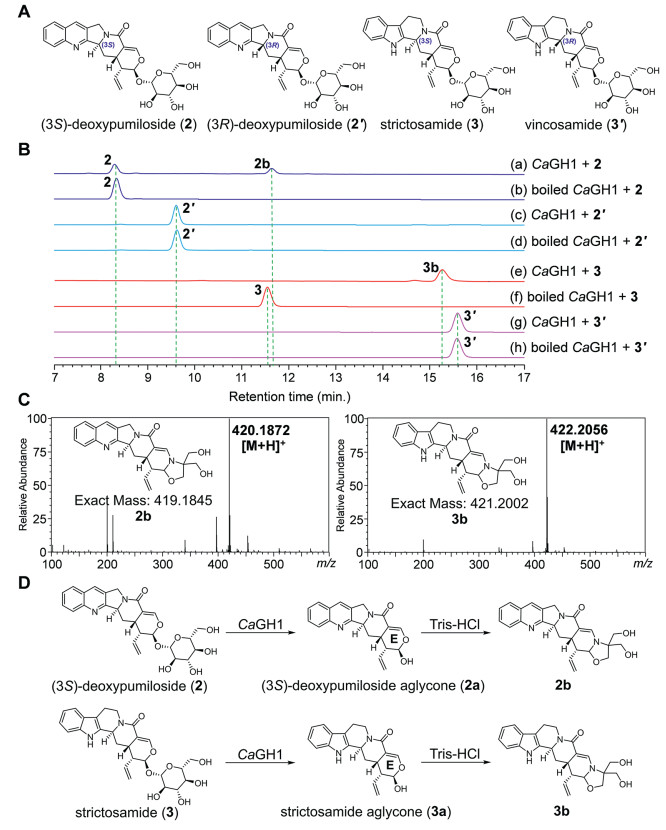-
[1]
M.E. Wall, M.C. Wani, C.E. Cook, et al., J. Am. Chem. Soc. 88 (1966) 3888–3890.
doi: 10.1021/ja00968a057
-
[2]
Y.H. Hsiang, R. Hertzberg, S. Hecht, L.F. Liu, J. Biol. Chem. 260 (1985) 14873–14878.
-
[3]
E. Kjeldsen, J.Q. Svejstrup, I.I. Gromova, J. Alsner, O. Westergaard, J. Mol. Biol. 228 (1992) 1025–1030.
-
[4]
X. Wu, M. Liu, C. Zheng, et al., Chin. Chem. Lett. 34 (2023) 107590.
-
[5]
H. Li, M. Zhang, J. He, et al., Chin. Chem. Lett. 36 (2025) 110615.
doi: 10.1016/j.cclet.2024.110615
-
[6]
A.L. Demain, P. Vaishnav, Microb. Biotechnol. 4 (2011) 687–699.
doi: 10.1111/j.1751-7915.2010.00221.x
-
[7]
W. Du, Tetrahedron 59 (2003) 8649–8687.
-
[8]
L. Song, Z. Lv, K. Zhang, et al., Asian J. Org. Chem. 11 (2022) e202200515.
-
[9]
A. Lorence, C.L. Nessler, Phytochemistry 65 (2004) 2735–2749.
-
[10]
J. Zhang, L.G. Hansen, O. Gudich, et al., Nature 609 (2022) 341–347.
doi: 10.1038/s41586-022-05157-3
-
[11]
Y. Liu, X. Li, S. Sui, et al., Acta Pharm. Sin. B 13 (2023) 1771–1785.
-
[12]
R. Yan, B. Xie, K. Xie, et al., Nat. Commun. 15 (2024) 3539.
-
[13]
M. López-Meyer, C.L. Nessler, Plant J. 11 (1997) 1167–1175.
doi: 10.1046/j.1365-313x.1997.11061167.x
-
[14]
F. Chen, W. Li, L. Jiang, et al., J. Ind. Microbiol. Biotechnol. 43 (2016) 1281–1292.
doi: 10.1007/s10295-016-1802-2
-
[15]
G. Collu, N. Unver, A.M.G. Peltenburg-Looman, et al., FEBS Lett. 508 (2001) 215–220.
-
[16]
Y. Sun, H. Luo, Y. Li, et al., BMC Genom. 12 (2011) 533.
-
[17]
A. Awadasseid, W. Li, Z. Liu, et al., Int. J. Biol. Macromol. 162 (2020) 1076–1085.
-
[18]
R. Sadre, M. Magallanes-Lundback, S. Pradhan, et al., Plant Cell 28 (2016) 1926–1944.
doi: 10.1105/tpc.16.00193
-
[19]
V. Salim, B. Wiens, S. Masada-Atsumi, F. Yu, V. De Luca. Phytochemistry 101 (2014) 23–31.
-
[20]
K. Asada, V. Salim, S. Masada-Atsumi, et al., Plant Cell 25 (2013) 4123–4134.
doi: 10.1105/tpc.113.115154
-
[21]
Y. Yang, W. Li, J. Pang, et al., ACS Chem. Biol. 14 (2019) 1091–1096.
doi: 10.1021/acschembio.8b01124
-
[22]
M. Kang, R. Fu, P. Zhang, et al., Nat. Commun. 12 (2021) 3531.
-
[23]
M. Yang, Q. Wang, Y. Liu, et al., BMC Biol. 19 (2021) 122.
-
[24]
J.C. Miller, A.J. Hollatz, M.A. Schuler, Phytochemistry 183 (2021) 112626.
-
[25]
Y. Yamazaki, H. Sudo, M. Yamazaki, N. Aimi, K. Saito, Plant Cell Physiol. 44 (2003) 395–403.
-
[26]
X. Pu, C. Zhang, H. Gao, et al., J. Chromatogr. A 11 (2020) 41.
-
[27]
N. Aimi, M. Nishimura, A. Miwa, et al., Tetrahedron Lett. 30 (1989) 4991–4994.
-
[28]
B.K. Carte, C. DeBrosse, D. Eggleston, et al., Tetrahedron 46 (1990) 2747–2760.
-
[29]
X. Pu, M. Wang, M. Chen, et al., ACS Chem. Biol. 18 (2023) 1772–1785.
doi: 10.1021/acschembio.3c00222
-
[30]
T. Zhang, Y. Wang, S. Wu, et al., J. Integr. Plant Biol. 66 (2024) 1044–1047.
doi: 10.1111/jipb.13594
-
[31]
V. Salim, A.D. Jones, D. DellaPenna, Plant J. 95 (2018) 112–125.
doi: 10.1111/tpj.13936
-
[32]
T.M. Nguyen, T. Nguyen, Y.Y. Leung, et al., Commun. Chem. 4 (2021) 177.
-
[33]
Y. Chen, J.P. Huang, Y.J. Wang, et al., J. Integr. Plant Biol. 66 (2024) 1158–1169.
doi: 10.1111/jipb.13649
-
[34]
L. Gao, C. Su, X. Du, et al., Nat. Chem. 12 (2020) 620–628.
doi: 10.1038/s41557-020-0467-7
-
[35]
Z. Fan, A. Jaisi, Y. Chen, et al., ACS Catal. 11 (2021) 8818–8828.
doi: 10.1021/acscatal.1c01514
-
[36]
R.S. Nett, E.S. Sattely, J. Am. Chem. Soc. 143 (2021) 19454–19465.
doi: 10.1021/jacs.1c08659
-
[37]
A. Geerlings, M.M. Ibañez, J. Memelink, R. van Der Heijden, R. Verpoorte, J. Biol. Chem. 275 (2000) 3051–3056.
-
[38]
H. Warzecha, I. Gerasimenko, T.M. Kutchan, J. Stöckigt, Phytochemistry 54 (2000) 657–666.
-
[39]
I. Gerasimenko, Y. Sheludko, X. Ma, J. Stöckigt, Eur J Biochem 269 (2002) 2204–2213.
-
[40]
Y. Wu, C. Liu, A. Koganitsky, F.L. Gong, S. Li, Angew. Chem. Int. Ed. 62 (2023) e202307995.
-
[41]
M. Kitajima, S. Yoshida, K. Yamagata, et al., Tetrahedron 58 (2002) 9169–9178.
-
[42]
C.R. Hutchinson, A.H. Heckendorf, J.L. Straughn, P.E. Daddona, D.E. Cane, J. Am. Chem. Soc. 101 (1979) 3358–3369.
doi: 10.1021/ja00506a037
-
[43]
R.S. Nett, Y. Dho, C. Tsai, et al., Nature 624 (2023) 182–191.
doi: 10.1038/s41586-023-06716-y
-
[44]
C. Li, X. Yin, S. Wang, et al., Angew. Chem. Int. Ed. 63 (2024) e202407070.
-
[45]
J.C. Liu, R.D.L. Peña, C. Tocol, E.S. Sattely, Nat. Commun. 15 (2024) 1419.

 Login In
Login In







 DownLoad:
DownLoad:


